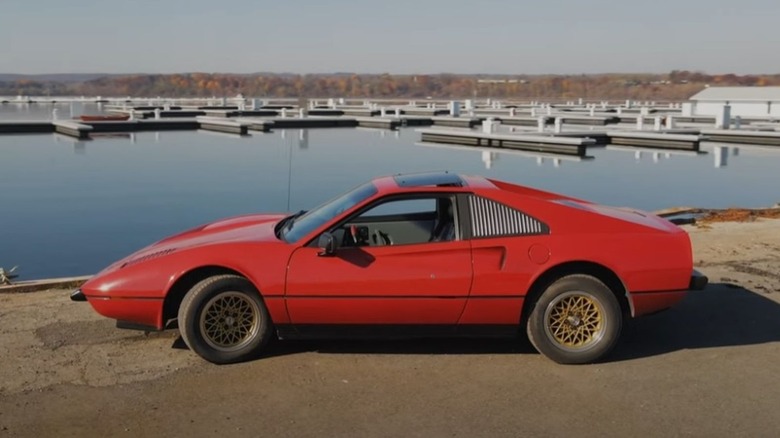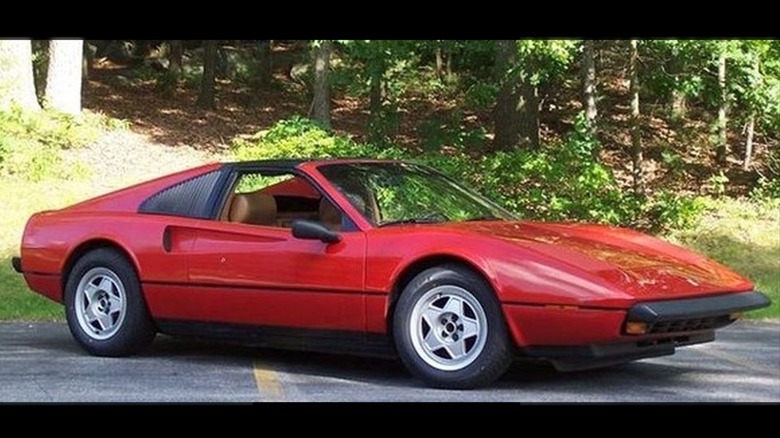The Rare Pontiac Fiero Model That Earned A Lawsuit From Ferrari
The Fiero was a short-lived attempt to reignite interest in what was once the legendary Pontiac name. It first hit the streets in 1984, and not only did it have a different look than most other cars, but the Fiero was also the first production mid-engine sports coupe built by an American car maker. If imitation is indeed the sincerest form of flattery, then someone at Pontiac really loved Ferrari. The Fiero was, in many ways, just a scaled-down version of the Italian masterpiece and felt very much like an overt homage to the European sportscar. From the similar-sounding name and looks (especially in the nose) to the engine's placement and use of a horse as the vehicle's badge, it was hard not to make the comparison.
Pontiac's early adoption of plastic body panels (attached to a spaceframe chassis acting as a roll cage) instead of metal allowed it to lighten the Fiero's curb weight and improve fuel efficiency. Despite selling well above expectations (almost 137,000 units) in '84, MotorTrend still called it "painfully slow" due to the hefty 2.5-liter Iron Duke straight-four (one of GM's most hated engines) weighing it all down.
The more significant issue, however, was it constantly had engine compartment fires, and in 1987, GM had to recall 125,000 first-year vehicles (over 91% of the total made). The use of bolt-on plastic body panels led directly to an odd collaboration between several Pontiac dealerships and a company that molded fiberglass for limited-production vehicles to create a Ferrari look-alike called the Mera.
If it looks like a horse, prances like a horse, and sounds like a horse...
After two years of working on a design and fabricating clay mock-ups, Bob Bracey, owner of Corporate Concepts Limited (CCL), unveiled a body kit in 1987 that turned the humble Fiero into a near-perfect replica of a Ferrari 308. Somehow, Bracey convinced several select Pontiac dealerships to sell his kit as a Pontiac Mera.
Here's how it worked. The customer would first buy a brand new Fiero from a dealer and order the kit as an "option." The car would then get shipped to the CCL plant in Capac, Michigan, where CCL would remove the original plastic body panels and replace them with new fiberglass components, complete with a new logo and badging. They also swapped the stock tires out for Goodyear 245/50VR-15 Gatorbacks with plastic wheel centers. In 1988, CCL offered replica 308 alloy wheels made by Cromadora in Italy. The Mera was available in red, white, silver, charcoal, and yellow. For an additional $700, you got reskinned seats that looked an awful lot like those found in a Ferrari.
Absolutely nothing was done to the actual mechanical components of the car, so it still drove and felt like a Fiero (quirks and all). According to Car and Driver, an audacious disclaimer in the brochure said: "There are no lines identical to any other vehicle produced now or in the past. The Mera is not represented to be nor meant to be a replica or look-alike to any other vehicle." Yet, there was no mistaking what the Mera was supposed to look like.
[Featured image by Drygolin via Wikimedia Commons | Cropped and scaled | CC BY-SA 3.0]
The Mera mirrored Ferrari a bit too much
Another interesting aspect was that Corporate Concepts Limited (CCL) did not sell these kits on the aftermarket. They were only available if you bought a new Fiero from a Pontiac dealership. Due to this caveat, a total of just 247 were ever made. In 1987, 88 were converted using the V6-powered Fierro GTs, while 159 were turned using the Fiero Formula as the base model the following year.
Despite looking almost identical to a Ferrari 308, no Mera was ever officially badged with a Prancing Horse logo, nor was the Ferrari name ever used for promotional purposes. In the years after, however, several owners took it upon themselves to swap badges, making it — at least at first glance — difficult to tell if you were looking at the real Italian deal or a mocked-up Michigan Mera. When available, it sold for an MSPR of between $24,000 and $28,000, depending on the level of conversion. While this was approximately three times more than a standard Fiero (which gets surprising figures at auctions these days), it was still half as much as a Ferrari 308.
Therefore, it should come as no shock that Ferrari pounced on CCL almost immediately and filed a trademark infringement suit claiming the Mera's body and exterior were simulations of the Ferrari 308 and 328. Needless to say, Ferrari won, CCL lost, and the 247 Mera's that were built have gone on to become some of the rarest collectibles in the automotive world.

